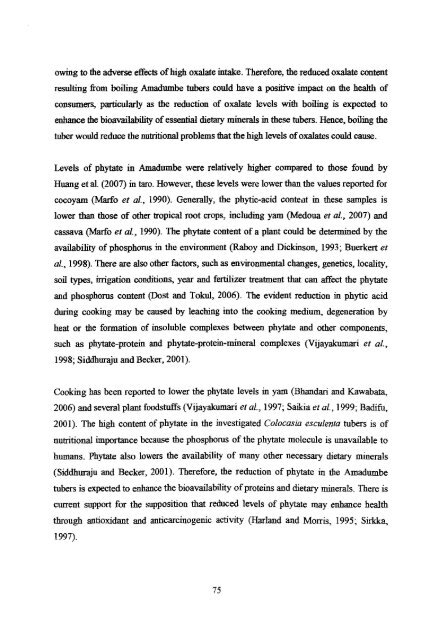ANTI-NUTRITIONAL CONSTITUENT OF COLOCASIA ESCULENTA ...
ANTI-NUTRITIONAL CONSTITUENT OF COLOCASIA ESCULENTA ...
ANTI-NUTRITIONAL CONSTITUENT OF COLOCASIA ESCULENTA ...
You also want an ePaper? Increase the reach of your titles
YUMPU automatically turns print PDFs into web optimized ePapers that Google loves.
owing to the adverse effects ofhigh oxalate intake. Therefore, the reduced oxalate content<br />
resulting from boiling Amadumbe tubers could have a positive impact on the health of<br />
consumers, particularly as the reduction of oxalate levels with boiling is expected to<br />
enhance the bioavailability ofessential dietary mineraJs in these tubers. Hence, boiling the<br />
tuber would reduce the nutritional problems that the high levels ofoxa1ates could cause.<br />
Levels of phytate in Amadnmbe were relatively higher compared to those found by<br />
Huang et al. (2007) in taro. However, these levels were lower than the values reported for<br />
cocoyam (Marfo et al., 1990). Generally, the phytic-acid conteJlt in these samples is<br />
lower than those of other tropical root crops, including yam (Medoua et aI., 2007) and<br />
cassava (Marfo et al., 1990). The phytate content of a plant could be determined by the<br />
availability of phosphorus in the environment (Raboy and Dickinson, 1993; Buerkert et<br />
aI., 1998). There are also other factors, such as environmental changes, genetics, locality,<br />
soil types, irrigation conditions, year and fertilizer treatment that can affect the phytate<br />
and phosphorus content (Dost and Tokul, 2006). The evident reduction in phytic acid<br />
during cooking may be caused by leaching into the cooking medium, degeneration by<br />
heat or the formation of insoluble complexes between phytate and other components,<br />
such as phytate-protein and phytate-protein-mineral complexes (Vijayakumari et aI.,<br />
1998; Siddhtrraju and Becker, 2001).<br />
Cooking has been reported to lower the phytate levels in yam (Bhandari and Kawabata,<br />
2006) and several plant foodstuffs (Vijayakumari et aI., 1997; Saikia et al., 1999; Badifu,<br />
2001). The high content of phytate in the investigated Colocasia esculenta tubers is of<br />
nutritional importance because the phosphorus of the phytate molecule is unavailable to<br />
humans. Phytate also lowers the availability of many other necessary dietary minerals<br />
(Siddhmaju and Becker, 2001). Therefore, the reduction of phytate in the Amadumbe<br />
tubers is expected to enhance the bioavailability ofproteins and dietary minerals. There is<br />
current support for the supposition that reduced levels of phytate may enhance health<br />
through antioxidant and anticarcinogenic activity (Harland and Morris, 1995; Sirkka,<br />
1997).<br />
75
















